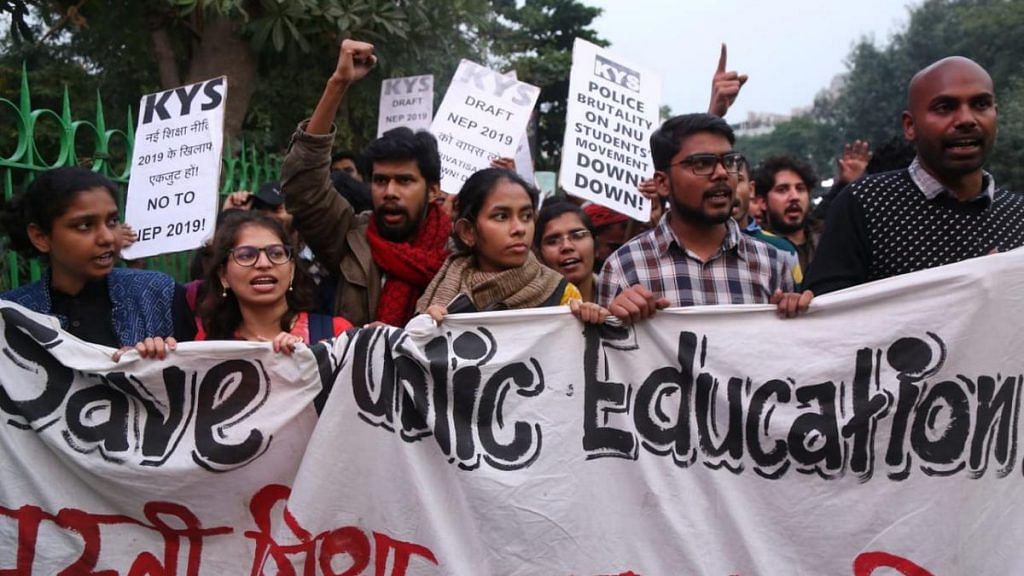Why does subsidised higher education scare Indians so much?
What is happening at Jawaharlal Nehru University is part of a larger trend in India where educational institutions are constantly under attack – from governments, from treasuries and from WhatsApp groups.
There have been constant attempts to destabilise campuses and student movements. The institutional murder of Rohith Vemula in Hyderabad Central University, the suicide of Payal Thadvi in TN Topiwala National Medical College after harassment, the death of Fathima Latheef in IIT Madras, Najeeb going missing in JNU, and finally, the protest against Feroz Khan teaching Sanskrit in Banaras Hindu University, all point to it.
Who would lose the most after the fee hike in JNU? Students from marginalised sections of society.
However, those criticising the hike must not cite the irrationality of public spending on statues or cows. That would convince the already biased Indian public that education and health are comparable to statues and cows.
To solve this crisis in higher education, we must first see students as students and not consumers, and education as a right, not a commodity.
Also read: If you still don’t understand JNU fee hike protest, read this story of Sunita
Rot in public universities
Let us get to the root of the matter.
In 1986, the National Policy on Education emphasised on the need for faculty enhancement and development. It gave a boost to privatisation of higher education in India.
In 2005, India ‘offered’ liberalisation of higher education under the World Trade Organisation-General Agreement on Trade in Services (WTO-GATS). The terms set by WTO-GATS towards achieving this goal included the basic principle of national treatment. It demands the government provide a ‘level playing field’ to corporations – to grant equal opportunity to both public and private institutions in the sector. It comes at the cost of affirmative action policies like reservations and financial support to various categories of students.
This makes the student a consumer, education a commodity and gives corporations the power to decide its price. The University Grants Commission (UGC) doesn’t want to invest in its institutions because the government wants to open higher education to market forces.
The All India Survey of Higher Education reports for 2013-14 and 2017-18 confirm the increasing trend of privatisation in India. The data tells us that the number of colleges in India has peaked from 36,634 to 39,050. While the proportion of privately managed colleges increased from 75 per cent to 78 per cent, the proportion of government colleges fell from 25 per cent to 22 per cent in the same period. However, 32.4 per cent of the students in India depend on these 22 per cent government colleges.
Out of the 903 universities in India, 560 (62 per cent) are publicly funded universities and 343 (38 per cent) are privately managed universities.
In February, the Tata Institute of Social Sciences decided to withdraw financial aid to students from Scheduled Castes, Scheduled Tribes and Other Backward Classes eligible for the government’s post-matric scholarship (GoI-PMS). It was an attempt to make quality education inaccessible to students from marginalised sections.
A major share of Adivasi and Dalit students in India depend on the GoI-PMS offered by the Centre and supplemented by the states. The cuts in the budget allocation, inconsistent disbursal of scholarships and the manufactured public sentiment against ‘freeloaders’ put subsidised higher education and social justice schemes in direct line of attack from the government, universities and the public alike.
It also paves the way for private players in the sector. It is a boon for corporate giants waiting to start their own Jio University (with an ‘Institution of Eminence’ tag gratis).
Also read: JNU fee row should make us ask if public and private universities are really any different
Selling education
People globally are losing trust in governments and are swiftly embracing the rule of corporations where charity by corporations is seen as more legitimate than public spending.
Public opinion will not align with students who question the corporations’ ‘intellectual colonisation’ of education. A good share of Indians thinks of education as a commodity that adds value to a human being in the marriage market rather than as a fundamental right. Investing in education is often a pension plan for parents than a basic necessity.
This public-spending antagonism targets social justice schemes whose principal beneficiaries are the poor and marginalised.
Also read: 3 years after Rohith Vemula’s suicide, not much has changed at University of Hyderabad
When the government implements the liberalisation of education with a Brahmanical ideology, it disentitles women, Dalits, Adivasis, religious and sexual minorities. The inability of the government and the universities to provide higher education, of the desired quality, to all who aspire for it and the lack of political commitment of public funds for it affect the economically weaker sections – those who most need education. It gives the ‘trader’ the power to choose their ‘consumers’. A ‘commodity’ cannot be a fundamental right of a ‘consumer’.
This crisis in education is a multi-layered one. And the iron-fist approach by the Modi government will not resolve it. At the same time, there can be no ‘middle’ ground in questions of principle. The government has to clarify its position on the future of subsidised higher education. It should hear the protesting students across India and acknowledge them as students and not consumers.
We cannot lose hope in this path of struggle. If we lose hope, we lose.
The author is an MLA from Vadgam constituency, Gujarat. Views are personal.
